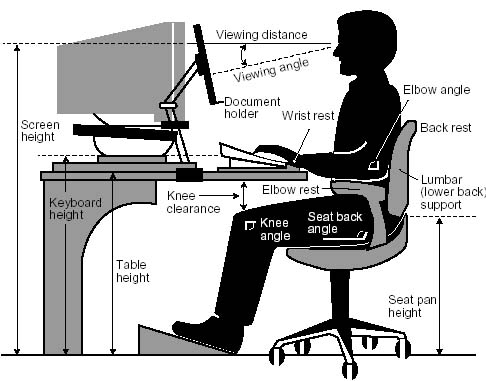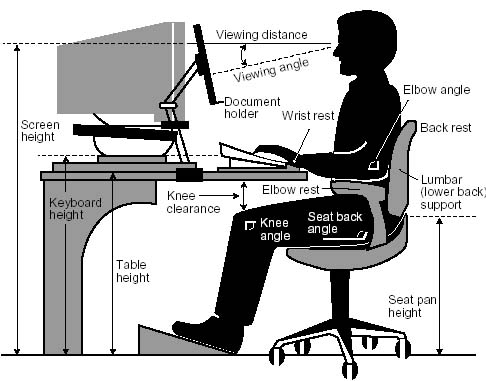Title Page
-
Employee Name
-
Supervisor Name
-
Conducted on
-
Prepared by
WORKING POSTURES
-
The workstation is designed or arranged for doing computer tasks so it allows your...
-
Head and neck are upright, or in-line with the torso (not bent down/back).
-
CORRECTIVE ACTIONS AND RECOMMENDATIONS.
-
Head, neck and trunk are facing forward and not twisted.
-
CORRECTIVE ACTIONS AND RECOMMENDATIONS.
-
Trunk is perpendicular to floor (may lean back into backrest but not forward).
-
CORRECTIVE ACTIONS AND RECOMMENDATIONS.
-
Shoulders and upper arms are in-line with the torso, generally about perpendicular to the floor and relaxed (not elevated or stretched forward). Elbows are close to the body and bent between 90 and 120 degrees.
-
CORRECTIVE ACTIONS AND RECOMMENDATIONS.
-
Upper arms and elbows are close to the body (not extended outward).
-
CORRECTIVE ACTIONS AND RECOMMENDATIONS.
-
Forearms, wrists, and hands are straight and in-line (forearm at about 90 degrees to the upper arm).
-
CORRECTIVE ACTIONS AND RECOMMENDATIONS.
-
Wrists and hands to be straight (not bent up/down or sideways toward the little finger).
-
CORRECTIVE ACTIONS AND RECOMMENDATIONS.
-
Thighs to be parallel to the floor and the lower legs to be perpendicular to the floor (thighs may be slightly elevated above knees).
-
CORRECTIVE ACTIONS AND RECOMMENDATIONS.
-
Feet rest flat on the floor or are supported by a stable footrest.
-
CORRECTIVE ACTIONS AND RECOMMENDATIONS.
SEATING
-
Consider these points when evaluating the chair...
-
Backrest provides support for your lower back (lumbar area).
-
CORRECTIVE ACTIONS AND RECOMMENDATIONS.
-
Seat width and depth accommodate the specific user (seat pan not too big or small).
-
CORRECTIVE ACTIONS AND RECOMMENDATIONS.
-
Seat front does not press against the back of your knees and lower legs (seat pan not too long).
-
CORRECTIVE ACTIONS AND RECOMMENDATIONS.
-
Seat has cushioning and is rounded with a "waterfall" front (no sharp edge).
-
CORRECTIVE ACTIONS AND RECOMMENDATIONS.
-
Armrests, if used, support both forearms while you perform computer tasks and they do not interfere with movement.
-
CORRECTIVE ACTIONS AND RECOMMENDATIONS.
KEYBOARD/MOUSE
-
Consider these points when evaluating the keyboard or pointing device. The keyboard and input device is designed or arranged for doing computer tasks so the...
-
Keyboard/mouse platform is stable and large enough to hold a keyboard and mouse.
-
CORRECTIVE ACTIONS AND RECOMMENDATIONS.
-
Mouse (or trackball) is located right next to your keyboard so it can be operated without reaching.
-
CORRECTIVE ACTIONS AND RECOMMENDATIONS.
-
Mouse (or trackball) is easy to use and the shape/size fits your hand (not too big or small).
-
CORRECTIVE ACTIONS AND RECOMMENDATIONS.
-
Wrists and hands do not rest on sharp or hard edges.
-
CORRECTIVE ACTIONS AND RECOMMENDATIONS.
MONITOR
-
Consider these points when evaluating the monitor. The monitor is designed or arranged for computer tasks so the...
-
Monitor position is directly in front of you so you don't have to twist your head or neck.
-
CORRECTIVE ACTIONS AND RECOMMENDATIONS.
-
Monitor distance allows you to read the screen without leaning your head, neck or trunk forward/backward.
-
CORRECTIVE ACTIONS AND RECOMMENDATIONS.
-
Top of the screen is at or below eye level so you can read it without bending your head or next down/back.
-
CORRECTIVE ACTIONS AND RECOMMENDATIONS.
-
Glare, from windows or lights, is not reflecting on your screen which can cause you to assume an awkward posture to clearly see information on your screen.
-
CORRECTIVE ACTIONS AND RECOMMENDATIONS.
WORK AREA
-
Consider these points when evaluating the desk and workstation. The work area is designed or arranged for doing computer tasks so the...
-
Thighs have sufficient clearance space between the top of the thighs and your computer table/keyboard platform (thighs are not trapped).
-
CORRECTIVE ACTIONS AND RECOMMENDATIONS.
-
Legs and feet have sufficient clearance space under the work surface so you are able to get close enough to the keyboard/mouse.
-
CORRECTIVE ACTIONS AND RECOMMENDATIONS.
ACCESSORIES
-
Check to see if...
-
Document holder, if provided, is stable and large enough to hold documents.
-
CORRECTIVE ACTIONS AND RECOMMENDATIONS.
-
Document holder, if provided, is placed at about the same height and distance as the monitor screen so there is little head movement, or need to re-focus, when you look from the document to the screen.
-
CORRECTIVE ACTIONS AND RECOMMENDATIONS.
-
Wrist/palm rest, if provided, is padded and free of sharp or square edges that push on your wrists.
-
CORRECTIVE ACTIONS AND RECOMMENDATIONS.
-
Wrist/palm rest, if provided, allows you to keep your forearms, wrist, and hands straight and in-line when using the keyboard/mouse.
-
CORRECTIVE ACTIONS AND RECOMMENDATIONS.
-
Telephone can be used with your head upright (not bent) and your shoulders relaxed (not elevated) if you do computer tasks at the same time.
-
CORRECTIVE ACTIONS AND RECOMMENDATIONS.
GENERAL
-
Workstation and equipment have sufficient adjustability so you are in a safe working posture and can make occasional changes in posture while performing computer tasks.
-
CORRECTIVE ACTIONS AND RECOMMENDATIONS.
-
Computer workstation, components and accessories are maintained in serviceable condition and functioning properly.
-
CORRECTIVE ACTIONS AND RECOMMENDATIONS.
-
Computer tasks are organized in a way that allows you to vary tasks with other work activities, or to take micro-breaks or recovery pauses while at the computer workstation.
-
CORRECTIVE ACTIONS AND RECOMMENDATIONS.
-
How many hours per day are you at your desk?
-
How many days per week do you work at your desk?
-
Has the employee or employee's supervisor submitted a claim to CorVel?
-
CORRECTIVE ACTIONS AND RECOMMENDATIONS.
RESOURCES
COMPONENTS
-
Desks
https://www.osha.gov/SLTC/etools/computerworkstations/components_desk.html -
Chairs
https://www.osha.gov/SLTC/etools/computerworkstations/components_chair.html -
Document Holders
https://www.osha.gov/SLTC/etools/computerworkstations/components_doc_holders.html -
Keyboards
https://www.osha.gov/SLTC/etools/computerworkstations/components_keyboards.html -
Monitors
https://www.osha.gov/SLTC/etools/computerworkstations/components_monitors.html -
Pointer/Mouse
https://www.osha.gov/SLTC/etools/computerworkstations/components_pointers.html -
Telephones
https://www.osha.gov/SLTC/etools/computerworkstations/components_telephone.html -
Wrist/Palm Supports
https://www.osha.gov/SLTC/etools/computerworkstations/components_wrist_rests.html
GOOD WORKING POSITIONS
-
Good Working Positions
https://www.osha.gov/SLTC/etools/computerworkstations/positions.html
PURCHASING GUIDE
-
Purchasing Guide
https://www.osha.gov/SLTC/etools/computerworkstations/checklist_purchasing_guide.html







